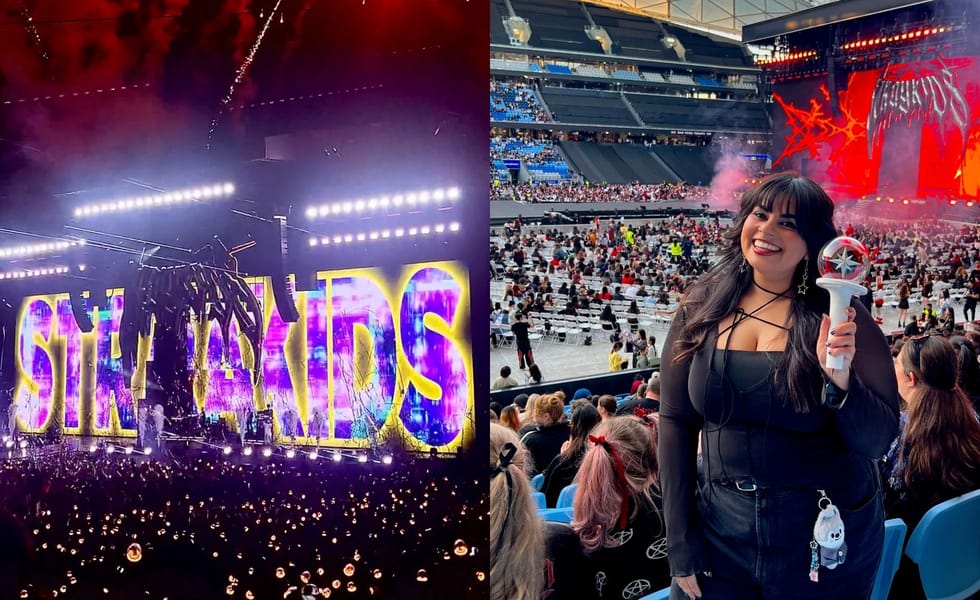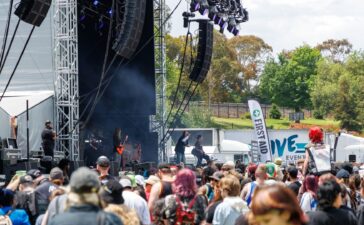K-pop concerts like Stray Kids are experiences that bring fans together, make them feel seen, and leave a mark long after the final encore.
Minutes before Stray Kids hit the stage, Sydney’s sold-out Allianz Stadium vibrated with anticipation. Thousands of lightsticks glowed in sync as fans clutched phones and merch, ready to scream their hearts out. My friend Alinah leaned over and apologised for the noises she was about to unleash.
I laughed it off. “All good. I don’t usually go feral at concerts.”
Three hours later, my voice was gone, throat raw, body buzzing with the crowd’s energy. Exhausted, I realised this was the happiest I’d been in a long time – all thanks to Stray Kids.
That night, I saw that K-pop concerts aren’t just about perfect vocals or flashy performances. They’re experiences that bring fans together, make them feel seen, and leave a mark long after the final encore.
The Collective Energy Of K-Pop Concerts
K-pop thrives on fandom culture, with every performance as much about the fans as the artists. Live Nation’s Australasia promoter Wenona Lok calls K-pop concerts “vibrant collective experiences,” thanks to the mix of music, choreography, theatrical production, and fan engagement – a combination “unlike anything else in the live entertainment sphere.”
That collective spirit starts months before the show in Facebook groups where fans plan meetups, chants, outfits, and fan projects. These communities turn the anticipation of a K-pop concert into something thrilling rather than overwhelming.
It also shows up in small but powerful ways IRL – like instantly connecting with strangers wearing the same merch. While Western music gigs stick to t-shirts, hoodies, and posters, K-pop takes it to a whole new level.
Fans show up with pickets, photocards, plushies, and handmade freebies. Merch isn’t just for collecting – it plugs fans into the community, broadcasts their bias, and turns concertgoers into one big fandom.
Then there’s the crown jewel: the lightstick, aka the ultimate symbol of fan identity. Programmed to sync with music, stage lighting, and choreography, it transforms the audience into a sparkling sea of colour – so even those in the nosebleeds feel part of the show.
For K-pop fans, every chant, outfit, freebie, and wave of a lightstick is a show of support for the members. Ultimately, they want the concert to be a memory they – and their bias – will never forget.
Why K-Pop Concerts Hit Different
Every element = from choreography and visuals to stage design, lighting, and audience interactions – is carefully curated to deepen the idol–fan bond.
VIP tickets bring fans even closer with soundcheck, sendoff, or hi-touch access. Soundcheck lets artists test audio in front of a small crowd, while sendoff and hi-touch give fans a quick post-show moment with idols. Even regular admission offers ways to connect, as K-pop stars make every seat feel special.
Concerts kick off with a high-energy performance before each member introduces themselves. Between songs, they joke around, shout out the city, start sing-offs, or even have the whole stadium celebrate a member’s birthday.
And it’s not just fun and games – they pause to watch fan projects, usually heartfelt video tributes. Seeing the idols’ emotional reactions alongside the crowd makes you feel like part of the exchange, even if you didn’t contribute.
That sense of closeness extends to the stage. Extended runways and moving carts bring members closer to fans, turning arenas into intimate spaces.
Even with a decent seat, I still felt pretty far away at Stray Kids’ Chicago show – baseball stadium problems, I guess. But then the carts rolled past, and all eight members were suddenly right in front of me. It was surreal… and yes, I’m 100% convinced Felix saw me and waved back (let me be delulu).
Moments like that highlight just how intentional K-pop concerts are in making fans feel included, valued, and part of something bigger. That electric connection is what makes them unforgettable – and puts Stray Kids at the forefront of a new era in live music.
The Stray Kids Effect
Self-discovery, perseverance, and forging your own path define Stray Kids. Since debuting in 2018, Bang Chan, Changbin, Felix, Han, Hyunjin, I.N, Lee Know, and Seungmin have become fourth-generation K-pop trailblazers, building a community beyond the stage.
“Stray Kids everywhere all around the world” isn’t just a slogan – it’s a call for fans to find their place in a global community. At concerts, chants, cheers, and a sea of glowing lightsticks ripple through the crowd, transforming it into one electrifying, connected whole.
Their dominATE world tour brought that global energy to life. Across 34 cities on five continents, 54 shows reached over a million STAYs, making it the biggest K-pop tour in Latin America, North America and Europe according to Billboard.
That feeling of ‘found family’ isn’t just felt in the arenas – it flows from the members to their fans. Bang Chan has spoken about his mental health struggles and eight years as a trainee, crediting the other members and STAYs with keeping him going.
Mutual support runs through every show, with Stray Kids constantly thanking STAYs for being part of their journey. Their music, in turn, offers comfort during tough times, creating a shared space where fans and idols grow together.
Feeling that energy live is unforgettable. My first Stray Kids concert was pure joy; my second brought me to tears as their songs mirrored my journey. Saying goodbye was harder than I expected, and I was already mentally counting down the days until I could see them live again.
On stage, their impact becomes undeniable – they’re not just performers; they’re the reason you cheer, cry, and feel inspired to keep growing.
K-pop concerts aren’t only about celebrating the music; they’re moments of connection, growth, and belonging that celebrate both idols and fans. By redefining what a concert can be, Stray Kids – and K-pop as a whole – are reshaping how we experience live music, proving it can be more than entertainment: it can be life-affirming.
As they say, once you become a STAY, you always stay.






